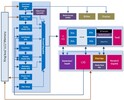AMD Radeon R2 (Mullins/Beema/Carrizo-L) vs Intel HD Graphics (Ivy Bridge) vs Intel HD Graphics (Braswell)
AMD Radeon R2 (Mullins/Beema/Carrizo-L)
► remove from comparison
Die AMD Radeon R2 ist eine in einigen Carrizo-L-, Mullins- und Beema-APUs (E1-6010, E2-6110, E1 Micro-6200T) von AMD integrierte Grafikeinheit. Sie verfügt über 128 Shadereinheiten auf Basis der GCN-Architektur (zwei Compute Units), die je nach Modell mit maximal 300 bis 600 MHz takten und beherrscht DirectX 12 (FL 12_0). Die Grafikkarte besitzt keinen eigenen Speicher, sondern greift über den Controller der APU auf den Hauptspeicher zu (modellabhängig Single-Channel DDR3L-1066/1333/1600).
Per UVD (Unified Video Decoder) kann die Radeon R2 den Prozessor beim Decodieren von Videos unterstützen, zudem wurde ein spezialisierter Video-Encoder (VCE 2.0) integriert. Das Bildsignal kann per VGA, DVI, HDMI 1.4a und DisplayPort 1.2 an bis zu zwei externe Monitore ausgegeben werden.
Die Performance der Radeon R2 kann sich durch unterschiedliche Taktraten von Modell zu Modell stark unterscheiden. Die schnellste Variante erreicht in etwa die Radeon HD 8330, in anderen Fällen entspricht die Leistung nur einer Radeon HD 8210. In der Regel werden nur ältere und anspruchslose Spiele flüssig bewältigt (Stand 2014).
Intel HD Graphics (Ivy Bridge)
► remove from comparison
Die Intel HD Graphics ist eine in den Ivy Bridge Prozessoren integrierte Grafikkarte. Sie kommt in den mobilen Celeron- und Pentium-Modellen zu Einsatz. Im Vergleich zur stärkeren Intel HD Graphics 4000, ist die HD Graphics deutlich abgespeckt und bietet weniger Execution Units (6 EUs) und Texture Sampler (nur einer). Daher ist die Performance deutlich geringer und liegt nur etwas oberhalb der alten Intel HD Graphics 2000. Je nach Prozessor weist die HD Graphics eine unterschiedliche Basis- und Turbo-Taktrate auf.
Da die Leistung nur zwischen der HD Graphics 2000 und 3000 liegt, ist die Ivy Bridge GT1 nur für ältere und anspruchslose Spiele ausreichend. Intel selbst gibt eine Geschwindigkeit 10-15% über der alten HD Graphics 2000 in Sandy Bridge CPUs an. Unsere Benchmarks (siehe weiter unten) zeigen eine Performance auf dem Niveau integrierter Einstiegslösungen von AMD wie der Radeon HD 8210.
Eine Besonderheit der Ivy Bride Grafikkerne ist, dass nur 4x MSAA von der Hardware unterstützt wird. 2x MSAA wird per Software berechnet und geht durch die 4x MSAA Pipeline. Daher empfiehlt sich der Einsatz des gleich schnellen 4x MSAA.
Auch der integrierte Videodecoder genannt Multi Format Codec Engine (MFX) wurde kräftig überarbeitet und soll nun sogar mehrere 4K Videos parallel dekodieren können (ev. nur in den High-End Modellen). DXVA Checker gibt weiterhin die Formate MPEG2, VC1, WMV9 und H264 als unterstützt an. QuickSync zum schnellen Transkodieren von Videos wurde ebenfalls verbessert und soll nun schneller bei gleichzeitig höherer Qualität laufen.
Ebenfalls neu ist die Unterstützung für drei unabhängige Bildschirme. Bis Sandy Bridge waren nur zwei möglich und lediglich die AMD Grafikkarten mit Eyefinity Support bieten mehr als zwei Anschlüsse für Notebooks (jedoch nur mit DisplayPort).
Aufgrund der Integration in den mit 22nm gefertigten Prozessor und die halbierte Shaderzahl ist der Stromverbrauch relativ gering und eignet sich auch für flache und kleine Notebooks.
Intel HD Graphics (Braswell)
► remove from comparison
Die Intel HD Graphics (Braswell) ist eine in den Low-End-SoCs der Braswell-Serie (z.B. Pentium N3700) integrierte Grafikeinheit. Sie basiert auf der gleichen Architektur wie die GPU verschiedener Broadwell-Prozessoren (z.B. HD Graphics 5300), bietet allerdings deutlich weniger Shadereinheiten und geringere Taktraten. Die genauen Spezifikationen hängen vom jeweiligen SoC ab: Die schnellste Variante mit 16 EUs und maximal 700 MHz schlägt die ältere HD Graphics (Bay Trail) um etwa Faktor zwei, andere Modelle mit lediglich 12 aktiven EUs schneiden etwas schlechter an. Zum Zeitpunkt der Vorstellung im ersten Quartal 2015 existieren folgende Varianten:
- Pentium N3700: 16 EUs @ 400 - 700 MHz, Dual-Channel Memory
- Celeron N3150: 12 EUs @ 320 - 640 MHz, Dual-Channel Memory
- Celeron N3050: 12 EUs @ 320 - 600 MHz, Dual-Channel Memory
- Celeron N3000: 12 EUs @ 320 - 600 MHz, Dual-Channel Memory
Anfangs wurde die GPU nur Intel HD Graphics benannt, später ab 2016 als Intel HD Graphics 400 (12 EU Version) und Intel HD Graphics 405 (16 EU Version) bezeichnet.
Anwender müssen sich deshalb insbesondere bei den Celeron-Modellen, die zusätzlich durch die Beschneidung auf nur zwei CPU-Kerne ausgebremst werden, auf ältere und anspruchslose Spiele beschränken. Videos werden dagegen auch in 4K/H.265 flüssig wiedergeben.
| AMD Radeon R2 (Mullins/Beema/Carrizo-L) | Intel HD Graphics (Ivy Bridge) | Intel HD Graphics (Braswell) | ||||||||||||||||||||||||||||||||||||||||||||||||||||||||||||||||||||||||||||||||||||||||||||||||||||||||||||||||||||||||||||||||||||||||||||||||||||||||||
| HD Graphics Serie |
|
|
| |||||||||||||||||||||||||||||||||||||||||||||||||||||||||||||||||||||||||||||||||||||||||||||||||||||||||||||||||||||||||||||||||||||||||||||||||||||||||
| Codename | Beema/Mullins | Ivy Bridge GT1 | Braswell | |||||||||||||||||||||||||||||||||||||||||||||||||||||||||||||||||||||||||||||||||||||||||||||||||||||||||||||||||||||||||||||||||||||||||||||||||||||||||
| Architektur | GCN 1.1 | Gen. 7 Ivy Bridge | Gen. 8 | |||||||||||||||||||||||||||||||||||||||||||||||||||||||||||||||||||||||||||||||||||||||||||||||||||||||||||||||||||||||||||||||||||||||||||||||||||||||||
| Pipelines | 128 - unified | 6 - unified | 16 - unified | |||||||||||||||||||||||||||||||||||||||||||||||||||||||||||||||||||||||||||||||||||||||||||||||||||||||||||||||||||||||||||||||||||||||||||||||||||||||||
| Kerntakt | 300 - 600 (Boost) MHz | 350 - 1100 (Boost) MHz | 320 - 700 (Boost) MHz | |||||||||||||||||||||||||||||||||||||||||||||||||||||||||||||||||||||||||||||||||||||||||||||||||||||||||||||||||||||||||||||||||||||||||||||||||||||||||
| Speicherbandbreite | 64 Bit | 64/128 Bit | 64/128 Bit | |||||||||||||||||||||||||||||||||||||||||||||||||||||||||||||||||||||||||||||||||||||||||||||||||||||||||||||||||||||||||||||||||||||||||||||||||||||||||
| Shared Memory | ja | ja | ja | |||||||||||||||||||||||||||||||||||||||||||||||||||||||||||||||||||||||||||||||||||||||||||||||||||||||||||||||||||||||||||||||||||||||||||||||||||||||||
| API | DirectX 12 (FL 12_0), Shader 5.0 | DirectX 11.0, Shader 5.0 | DirectX 11.2, Shader 5.0 | |||||||||||||||||||||||||||||||||||||||||||||||||||||||||||||||||||||||||||||||||||||||||||||||||||||||||||||||||||||||||||||||||||||||||||||||||||||||||
| Herstellungsprozess | 28 nm | 22 nm | 14 nm | |||||||||||||||||||||||||||||||||||||||||||||||||||||||||||||||||||||||||||||||||||||||||||||||||||||||||||||||||||||||||||||||||||||||||||||||||||||||||
| Erscheinungsdatum | 29.04.2014 | 01.10.2012 | 01.04.2015 |
|
|
| ||||||||||||||||||||||||||||||||||||||||||||||||||||||||||||||||||||||||
Benchmarks
3DM Vant. Perf. total + AMD Radeon R2 (Mullins/Beema/Carrizo-L)
specvp11 snx-01 + Intel HD Graphics (Ivy Bridge)
Cinebench R15 OpenGL 64 Bit + AMD Radeon R2 (Mullins/Beema/Carrizo-L)
GFXBench T-Rex HD Offscreen C24Z16 + AMD Radeon R2 (Mullins/Beema/Carrizo-L)
Average Benchmarks AMD Radeon R2 (Mullins/Beema/Carrizo-L) → 100% n=16
Average Benchmarks Intel HD Graphics (Ivy Bridge) → 94% n=16
Average Benchmarks Intel HD Graphics (Braswell) → 93% n=16
* Smaller numbers mean a higher performance
1 This benchmark is not used for the average calculation
Spiele-Benchmarks
Die folgenden Benchmarks basieren auf unseren Spieletests mit Testnotebooks. Die Performance dieser Grafikkarte bei den gelisteten Spielen ist abhängig von der verwendeten CPU, Speicherausstattung, Treiber und auch Betriebssystem. Dadurch müssen die untenstehenden Werte nicht repräsentativ sein. Detaillierte Informationen über das verwendete System sehen Sie nach einem Klick auf den fps-Wert.

FIFA 16
2015
World of Warships
2015
Metal Gear Solid V
2015
Dirt Rally
2015
Battlefield Hardline
2015
Evolve
2015
Far Cry 4
2014
F1 2014
2014
Alien: Isolation
2014
Sims 4
2014
Risen 3: Titan Lords
2014
GRID: Autosport
2014
Thief
2014
X-Plane 10.25
2013
F1 2013
2013
Fifa 14
2013
Saints Row IV
2013
Dota 2
2013
GRID 2
2013
Metro: Last Light
2013
BioShock Infinite
2013
Tomb Raider
2013
Crysis 3
2013
Dead Space 3
2013
Hitman: Absolution
2012
Dishonored
2012
Fifa 13
2012
F1 2012
2012
Guild Wars 2
2012
Counter-Strike: GO
2012
Dirt Showdown
2012
Diablo III
2012
Fifa 12
2011
Dirt 3
2011
StarCraft 2
2010Average Gaming AMD Radeon R2 (Mullins/Beema/Carrizo-L) → 100%
Average Gaming 30-70 fps → 100%
Average Gaming Intel HD Graphics (Ivy Bridge) → 108%
Average Gaming 30-70 fps → 107%
Average Gaming Intel HD Graphics (Braswell) → 71%
Average Gaming 30-70 fps → 81%
| AMD Radeon R2 (Mullins/Beema/Carrizo-L) | low | med. | high | ultra | QHD | 4K |
|---|---|---|---|---|---|---|
| FIFA 16 | 22.6 | 14.8 | ||||
| World of Warships | 27.7 | 18.8 | ||||
| Dirt Rally | 48.4 | 15 | ||||
| Battlefield Hardline | 22.4 | 15.6 | ||||
| F1 2014 | 37 | 26 | ||||
| Sims 4 | 78.7 | 23.7 | ||||
| GRID: Autosport | 34 | 23.5 | ||||
| BioShock Infinite | 18 | 10 | 8.9 | |||
| Tomb Raider | 24 | 13 | 12.2 | |||
| Counter-Strike: GO | 43.6 | 34.5 | ||||
| Diablo III | 22.5 | |||||
| Anno 2070 | 25.2 | 11.9 | ||||
| StarCraft 2 | 27.1 | 12.4 | ||||
| World of Warcraft | 30.6 | 27.8 | 7 | |||
| < 30 fps < 60 fps < 120 fps ≥ 120 fps | 8 5 1 | 11 1 | 4 | | | |
| Intel HD Graphics (Braswell) | low | med. | high | ultra | QHD | 4K |
|---|---|---|---|---|---|---|
| World of Warships | 16.8 | 11.9 | ||||
| Metal Gear Solid V | 13.7 | 9.5 | ||||
| Dirt Rally | 27.2 | 7.1 | ||||
| Battlefield Hardline | 13.2 | 8.7 | ||||
| Evolve | 5.4 | 3.9 | ||||
| Dragon Age: Inquisition | 8.2 | 6.1 | ||||
| Far Cry 4 | 6.1 | 4.3 | ||||
| Civilization: Beyond Earth | 6 | 3.2 | ||||
| F1 2014 | 13 | 12 | ||||
| Alien: Isolation | 13.7 | 8.8 | ||||
| Sims 4 | 64 | 18.7 | ||||
| Risen 3: Titan Lords | 7.9 | 5.6 | ||||
| GRID: Autosport | 23 | 12.5 | ||||
| Saints Row IV | 3.8 | 2.1 | ||||
| GRID 2 | 19.2 | 12.6 | 12.5 | |||
| BioShock Infinite | 18 | 10 | 8 | |||
| Tomb Raider | 22 | 12 | 8 | |||
| Crysis 3 | 9.3 | 5.7 | 2.1 | |||
| Dead Space 3 | 28.6 | 13 | 9.9 | |||
| Dishonored | 15 | 12 | 11.3 | |||
| Counter-Strike: GO | 12.2 | 11.5 | 10.4 | |||
| Diablo III | 25.5 | 16.7 | 13.2 | |||
| Anno 2070 | 29 | 13 | 8.1 | |||
| The Elder Scrolls V: Skyrim | 16.5 | 8.2 | 5 | |||
| Deus Ex Human Revolution | 28 | 13.9 | ||||
| Battlefield: Bad Company 2 | 6.7 | 4.2 | 2.1 | |||
| Trackmania Nations Forever | 97 | 23 | ||||
| < 30 fps < 60 fps < 120 fps ≥ 120 fps | 25 2 | 25 | 13 | | | |
| Intel HD Graphics (Ivy Bridge) | low | med. | high | ultra | QHD | 4K |
|---|---|---|---|---|---|---|
| The Elder Scrolls Online | 34.5 | 14.3 | 8.6 | |||
| Thief | 5.9 | 3.6 | ||||
| X-Plane 10.25 | 15 | 7.6 | ||||
| F1 2013 | 20 | 14 | ||||
| Fifa 14 | 54.4 | 32 | ||||
| Dota 2 | 24 | 16 | ||||
| GRID 2 | 27.54 | 12.84 | 12.5 | |||
| Metro: Last Light | 10.52 | 8.09 | 4.35 | |||
| BioShock Infinite | 17 | 9 | 7.72 | |||
| StarCraft II: Heart of the Swarm | 96 | 22 | 13 | 4 | ||
| Tomb Raider | 20 | 11 | 7 | |||
| Dead Space 3 | 42 | 17 | 12 | 6 | ||
| Hitman: Absolution | 13 | 11 | 4 | |||
| Dishonored | 19 | 15 | ||||
| Fifa 13 | 58 | 36 | 20 | 13 | ||
| F1 2012 | 23 | 19 | 16 | 12 | ||
| Guild Wars 2 | 30 | 8 | 5 | |||
| Counter-Strike: GO | 37 | 20 | 11 | |||
| Dirt Showdown | 36 | 13 | ||||
| Diablo III | 29.2 | 17.5 | 14.6 | |||
| Anno 2070 | 26 | 12 | 8 | |||
| The Elder Scrolls V: Skyrim | 16 | 9 | 4.55 | |||
| Fifa 12 | 55.8 | 21.2 | ||||
| Deus Ex Human Revolution | 25.4 | 11.4 | ||||
| Dirt 3 | 41.4 | 16.5 | ||||
| Trackmania Nations Forever | 90 | 20.7 | ||||
| World of Warcraft | 78.3 | 28.3 | ||||
| < 30 fps < 60 fps < 120 fps ≥ 120 fps | 15 6 3 | 20 4 | 18 1 | 6 | | |
Eine Liste mit weiteren Spielen und allen Grafikkarten finden Sie auf unserer Seite: Welches Spiel ist mit welcher Grafikkarte spielbar?




















